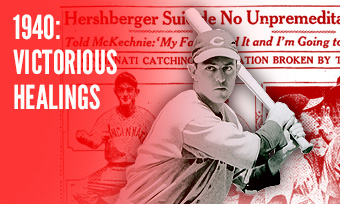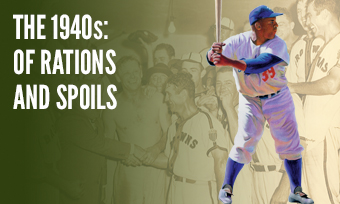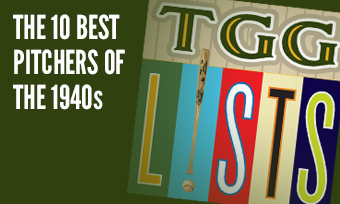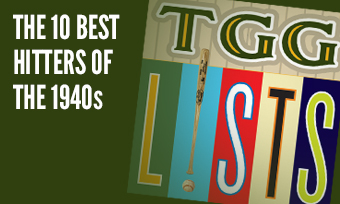The Yearly Reader
Leaders and Honors, 1940
Our list of baseball’s top 10 hitters and pitchers in both the American League and National League for the 1940 baseball season, as well as the awards and honors given to the game’s top achievers of the year.
The National League’s Top 10 Hitters, 1940
Bold type in brick red indicates league leader.
1. Johnny Mize, St. Louis
Key Numbers: .314 average, 111 runs, 182 hits, 31 doubles, 13 triples, 43 home runs, 137 RBIs, 82 walks, 24 intentional walks, .636 slugging percentage.
Mize had two things in common with future Colorado slugger Andres Galarraga: The same nickname (“Big Cat”) and statistics worthy of Coors Field. He became the only player until Mookie Betts (in 2018) to have a pair of three-homer games and a cycle in the same season.
2. Dolph Camilli, Brooklyn
Key Numbers: .287 average, 92 runs, 29 doubles, 13 triples, 23 home runs, 96 RBIs, 89 walks.
In his third year at Brooklyn, Camilli barely failed to reach triple-digits in runs, RBIs and walks for a third straight year—but at least he didn’t strike out 100 times for a third straight season as well.
3. Arky Vaughan, Pittsburgh
Key Numbers: 156 games, .300 average, 113 runs, 178 hits, 40 doubles, 15 triples, 7 home runs, 95 RBIs, 88 walks, 12 stolen bases.
The typically agile shortstop used his bat to make up for a major league-high 52 errors committed on the year.
4. Elbie Fletcher, Pittsburgh
Key Numbers: .273 average, 94 runs, 22 doubles, 7 triples, 16 home runs, 104 RBIs, 119 walks, 9 hit-by-pitches, .418 on-base percentage.
Reaching the top of his game, Fletcher managed to reach base almost as often via walk, hit batsmen or error (134) as he did by hits (139).
5. Frank McCormick, Cincinnati
Key Numbers: .309 average, 618 at-bats, 93 runs, 191 hits, 44 doubles, 19 home runs, 127 RBIs, 20 sacrifice hits, 23 grounded into double plays.
The unsung star crooned MVP voters into giving him the honor after peaking along with the Reds and leading the NL in hits for the third straight season.
6. Enos Slaughter, St. Louis
Key Numbers: 140 games, .306 average, 96 runs, 25 doubles, 13 triples, 17 home runs, 73 RBIs.
Three of Slaughter’s nine career multiple-homer games took place during the 1940 season—20 days apart in July.
7. Bill Nicholson, Chicago
Key Numbers: 135 games, .297 average, 78 runs, 27 doubles, 7 triples, 25 home runs, 98 RBIs.
After bouncing around the A’s and Senators’ organizations through the late 1930s, Nicholson made a firm everyday splash after former Cubs star Kiki Cuyler helped perfect his stance.
8. Mel Ott, New York
Key Numbers: .289 average, 89 runs, 27 doubles, 19 home runs, 79 RBIs, 100 walks.
A relatively sedate showing but still efficient effort for the future Hall of Famer; who knows how much lower his home run count would have been had it not for the micro-distant lengths to the Polo Grounds’ foul poles.
9. Stan Hack, Chicago
Key Numbers: .317 average, 101 runs, 191 hits, 38 doubles, 6 triples, 8 home runs, 75 walks, 21 stolen bases, 22 caught stealing.
By today’s rules, Hack would have been the NL batting champ—but there were no official such rules in 1940, so they gave it instead to the Pirates’ Debs Garms, who hit .355 despite playing just 103 games.
10. Hank Leiber, Chicago
Key Numbers: 117 games, .302 average, 17 home runs, 86 RBIs.
A near-Xeroxed campaign in which the outfielder’s season was once again shortened by injuries, reducing the potential for some awesome numbers.
The American League’s Top 10 Hitters, 1940
1. Hank Greenberg, Detroit
Key Numbers: .340 average, 129 runs, 195 hits, 50 doubles, 8 triples, 41 home runs, 150 RBIs, 93 walks, .670 slugging percentage.
Closing out the prodigious pre-war stage of his career, Greenberg pocketed an extra $10,000 to relocate to the outfield and make room at first base for all-hit, no-glove catcher Rudy York; both excelled.
2. Ted Williams, Boston
Key Numbers: .344 average, 134 runs, 193 hits, 43 doubles, 14 triples, 23 home runs, 113 RBIs, 96 walks, .442 on-base percentage.
Despite outstanding sophomore numbers, the honeymoon was over for Williams at Fenway Park, going nose-to-nose with local fans and press before demanding (and being denied) a trade to Detroit.
3. Joe DiMaggio, New York
Key Numbers: 132 games, .352 average, 93 runs, 179 hits, 28 doubles, 9 triples, 31 home runs, 133 RBIs, 61 walks.
DiMaggio put together the year’s longest hitting streak at 23 games. That, of course, would be nothing compared to what he had in store the following season.
4. Rudy York, Detroit
Key Numbers: 155 games, .316 average, 105 runs, 186 hits, 46 doubles, 6 triples, 33 home runs, 134 RBIs, 89 walks.
Graciously given the first base job by Hank Greenberg, York graciously gave back with arguably his finest year.
5. Jimmie Foxx, Boston
Key Numbers: .297 average, 106 runs, 30 doubles, 36 home runs, 119 RBIs, 101 walks.
Foxx returned behind the plate where his big-league career began 15 years earlier, giving hot-hitting Lou Finney an everyday role at first.
6. Joe Cronin, Boston
Key Numbers: .285 average, 104 runs, 35 doubles, 6 triples, 24 home runs, 111 RBIs, 83 walks.
An impressive vintage performance by the 34-year-old player-manager, spiked with a career high in home runs.
7. Barney McCosky, Detroit
Key Numbers: .340 average, 123 runs, 200 hits, 39 doubles, 19 triples, 67 walks, 13 stolen bases.
One of three American Leaguers to co-lead the circuit with exactly 200 hits, McCosky enjoyed his second and finest season at the big-league level; World War II would deprive him of his potential peak years (1943-45). Four times in 1940, he had multiple triples in a game to set an AL mark tied in 2004 by Carl Crawford.
8. Charlie Keller, New York
Key Numbers: .286 average, 102 runs, 18 doubles, 15 triples, 21 home runs, 93 RBIs, 106 walks.
The former minor league player of the year (1937) hit full stride at the major league level—though with only seven of his jacks hit at Yankee Stadium, he still had to yet to take advantage of the park’s short right-field porch.
9. Joe Kuhel, Chicago
Key Numbers: 155 games, .280 average, 111 runs, 169 hits, 28 doubles, 8 triples, 27 home runs, 94 RBIs, 87 walks, 12 stolen bases.
Kuhel finally won over White Sox fans who were still angry with the trade that sent him to Chicago for popular Zeke Bonura.
10. Joe Gordon, New York
Key Numbers: 155 games, .281 average, 112 runs, 173 hits, 32 doubles, 10 triples, 30 home runs, 103 RBIs, 18 stolen bases.
The third-year second baseman did his best to pick up the slack from a Yankee roster whose stars of the 1930s were starting to skip gears.
The National League’s Top 10 Pitchers, 1940
1. Bucky Walters, Cincinnati
Key Numbers: 2.48 ERA, 22 wins, 10 losses, 36 starts, 29 complete games, 305 innings.
Performing a carbon copy of his 1939 effort, Walters again lead the NL in wins, complete games, innings, ERA and opponents’ batting average.
2. Claude Passeau, Chicago
Key Numbers: 2.50 ERA, 20 wins, 13 losses, 5 saves, 46 appearances, 31 starts, 280.2 innings, 59 walks.
Thrilled to be exiled from the down-and-out Phillies, Passeau enjoyed the second and best of eight straight years finishing .500 or above at Chicago.
3. Rip Sewell, Pittsburgh
Key Numbers: 2.80 ERA, 16 wins, 5 losses, .762 win percentage, 33 appearances, 23 starts.
Having finally graduated to the major league stage in his early 30s, Sewell transformed into (mostly) a starter with the Bucs and easily became the team’s most effective arm.
4. Paul Derringer, Cincinnati
Key Numbers: 3.06 ERA, 20 wins, 12 losses, 37 starts, 26 complete games, 296.2 innings, 48 walks.
In a 15-year career, Derringer would never throw a no-hitter but did fire two one-hitters—both of those in 1940.
5. Jim Turner, Cincinnati
Key Numbers: 2.89 ERA, 14 wins, 7 losses, 187 innings, 32 walks.
The 37-year-old hurler, in just his fourth major league season, provided the most efficient support in the Reds’ staff beyond the one-two crunch of Walters and Derringer.
6. Larry French, Chicago
Key Numbers: 3.29 ERA, 14 wins, 14 losses, 40 appearances, 33 starts, 246 innings.
French’s solid, steady if not dominant pitching finally earned him his first and only All-Star spot.
7. Lon Warneke, St. Louis
Key Numbers: 3.14 ERA, 16 wins, 10 losses, 232 innings, 47 walks.
Now pitching for the Cardinals after his heyday with the Cubs during the early 1930s, Warneke warmed up for his future role as a major league umpire by filling in for an arbiter after a scheduling mix-up.
8. Manny Salvo, Boston
Key Numbers: 3.08 ERA, 10 wins, 9 losses, 20 starts, 14 complete games, 5 shutouts, 160.2 innings.
Stuck with the minors in Jersey to start the year, Salvo was dealt from the Giants to Boston for fading infielder Tony Cuccinello and responded by leading the league in shutouts—one of them against his old team on August 14.
9. Junior Thompson, Cincinnati
Key Numbers: 3.32 ERA, 16 wins, 9 losses, 31 starts, 17 complete games, 225.1 innings, 28 grounded into double plays.
Junior, who went by his formal name “Gene” by some, saw his career peak with a career-high number of wins. He’d eventually become a scout for over 50 years, retiring before his death in 2005.
10. Dick Errickson, Boston
Key Numbers: 3.16 ERA, 12 wins, 13 losses, 29 starts, 17 complete games, 236.1 innings, 29 grounded into double plays, four stolen bases allowed, 13 caught stealing.
Errickson managed a strong ERA despite a losing record and the NL’s worst modern-era K/BB ratio—with only 34 strikeouts against 90 walks.
The American League’s Top 10 Pitchers, 1940
1. Bob Feller, Cleveland
Key Numbers: 2.61 ERA, 27 wins, 11 losses, .711 win percentage, 4 saves, 43 appearances, 37 starts, 31 complete games, 4 shutouts, 320.1 innings, 118 walks, 261 strikeouts.
Feller delivered his usual heat to rack up a personal high in wins, his only ERA title and his first no-hitter—but also took a lot of heat for his role as co-conspirator in the failed mutiny to oust skipper Ossie Vitt.
2. Bobo Newsom, Detroit
Key Numbers: 2.83 ERA, 21 wins, 5 losses, .808 win percentage, 36 appearances, 34 starts, 264 innings, 100 walks.
The often abrasive Newsom had the most satisfying year of his career—statistically, anyway, setting personal bests in wins and win percentage.
3. Johnny Rigney, Chicago
Key Numbers: 3.11 ERA, 14 wins, 18 losses, 39 appearances, 33 starts, 19 complete games, 280.2 innings.
Strangely, Rigney posted the White Sox’ best ERA despite a losing record on a team with a winning mark.
4. Marius Russo, New York
Key Numbers: 3.28 ERA, 14 wins, 8 losses.
An agreeable first full year for the young lefty who preferred to sign autographs right-handed to “rest” his pitching arm.
5. Al Milnar, Cleveland
Key Numbers: 3.27 ERA, 18 wins, 10 losses, 37 appearances, 33 starts, 4 shutouts, 242.1 innings.
A career year for a guy who had 20 wins in his sights before a lackluster final couple of months to the season deprived him of reaching that goal.
6. Tommy Bridges, Detroit
Key Numbers: 3.37 ERA, 12 wins, 9 losses, 197.2 innings, 133 strikeouts.
Thank goodness for the Browns; Bridges was 5-1 with a 1.94 ERA against the AL dreg, while he was 7-8 with a 3.80 figure against everyone else.
7. Al Smith, Cleveland
Key Numbers: 3.44 ERA, 15 wins, 7 losses, .682 win percentage, 31 appearances, 24 starts, 11 complete games, 183 innings.
After his teammate Bob Feller, Smith had the AL’s lowest batting average allowed at .228.
8. Schoolboy Rowe, Detroit
Key Numbers: 3.46 ERA, 16 wins, 3 losses, .842 win percentage, 23 starts, 11 complete games, 169 innings.
Dogged by an exhausted arm that nearly ended his career, Rowe refreshed and regained strength as the year went along, winning five games in the home stretch as the Tigers barreled into the World Series.
9. Eddie Smith, Chicago
Key Numbers: 3.21 ERA, 14 wins, 9 losses, 28 starts, 12 complete games, 207.1 innings.
Of the southpaw’s 10 major league seasons, this would be his only one with a winning record; he otherwise posted a 59-104 mark for his career.
10. Thornton Lee, Chicago
Key Numbers: 3.47 ERA, 12 wins, 13 losses, 24 complete games, 228 innings.
Like Johnny Rigney above, Lee struggled in his attempts to reach the .500 mark in spite of solid pitching. That would change in 1941.









